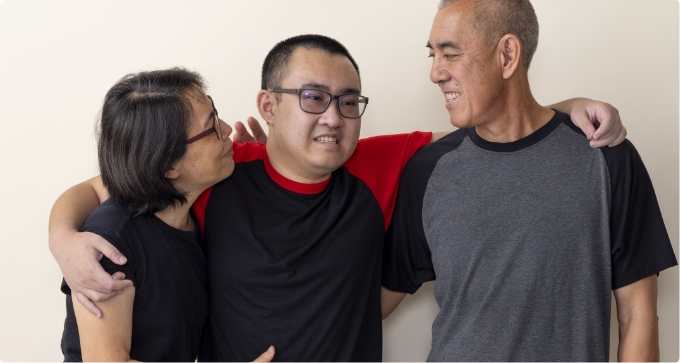About the Autism Society
Who We Are
Since 1965, the Autism Society of America, and our affiliate network, connects people to the resources they need through education, advocacy, resources, and community programming.

Mission & Vision
Mission
We create connections, empowering everyone in the Autism community with the resources needed to live fully.
Vision
Creating a world where everyone in the Autism community is connected to the support they need, when they need it.
The Autism Society strives to empower individuals with Autism and their families to make informed decisions in the planning and delivery of individualized, evidence-based services and support. Each individual and family has the right to choose the services that best meet their individual needs.
Making Informed Decisions
The Board of Directors of the Autism Society affirms that each person who experiences Autism is a unique individual. To the maximum extent possible, informed decisions should be made by the individual with Autism and their family members in partnership with a multidisciplinary team.
The selection of current evidence-based intervention practices should be guided by objective assessment, goals, and outcomes. Services and support should be delivered with fidelity by qualified and appropriately trained professionals. All services should promote self-determination, enhance inclusive community engagement, and result in improved quality of life. Abuse of any kind is not acceptable.
No single service or intervention is likely to meet the needs of every individual with Autism. Each person should have broad and equal access to high quality, individualized support and services. Selection of a program, service, or intervention method should be based on a comprehensive assessment of the person’s abilities, needs, and interests. Services should be outcome-based to ensure they meet the individualized goals of the person with Autism.

The Board of the Autism Society expects that individuals with Autism will have dignified, productive lives and reach their fullest potential through access to appropriate education, employment, community living opportunities, medical care, mental health services, and family support.
Guiding Principles For Selecting Interventions and Therapies
As the number of individuals being diagnosed with Autism has increased, so too have medical, educational, and clinical options. When making informed decisions about clinical and therapeutic options, family members, professionals, and individuals who experience Autism often find choices to be complex and confusing.
The overwhelming amount of information available via the internet, social media, and news media, which highlight stories about the successes of proven and unproven treatments, makes these decisions even more challenging. In response, we have created the following guiding principles for those who need to make choices among the vast array of available service and support options.
- The Autism Society recognizes the wide diversity of the Autism experience in terms of needs and support across the lifespan. This makes it clear that there is no one-size-fits-all approach to address the needs and goals set for all individuals with Autism.
- A wide range of therapies, support, and services should be equitably available to all people with Autism. Professionals must be proactive in ensuring that all individuals with Autism receive effective interventions without discrimination and regardless of where they live, their racial/ethnic status, their economic conditions, or other factors that might otherwise limit equitable access.
- Individuals with Autism and their family members should critically evaluate the information and services highlighted on various websites. To obtain a balanced perspective, ensure information is from objective sources, including the Autism Society and their affiliates. Remember that those providing various services may genuinely want to help your child but may have additional motives for recruiting your business.
- Individuals with Autism and their family members should be considered equal partners in treatment. Family members and individuals should understand the process for developing and approving all interventions and therapies or clinical treatment plans. Parents and individuals should be encouraged to ask questions and request detailed explanations as well as decline any interventions they feel will have the potential to cause harm.
- Individuals with Autism and their family members should weigh the impact of the chosen services and support on the entire family along a variety of dimensions, including fit within the family structure, time commitment, safety risk, financial impact, and other important factors. Individuals with Autism and their family members know themselves, their child, and the needs of their family best. They are the ultimate decision-makers regarding medical, mental health, educational, vocational, and other person-centered support and services.
- Individuals with Autism and their family members should never hesitate to ask questions about the professional providing services, including licenses, certifications, previous experiences, and documented expertise. This should come from the professional as well as independent resources.
- Individuals with Autism and their family members should expect clear communication about progress, which is typically documented using data. All practitioners should present data in a format that is understandable and that shows whether there is improvement.
- Treatment providers must respect the dignity of the individual with Autism. Treatments should never be demeaning, embarrassing, or aversive. Individuals with Autism and their family members should never hesitate to question practices that they don’t understand or that make them feel uncomfortable. Effective professionals are those who can establish a positive rapport with individuals with Autism and their families. Individuals with Autism and their family members should be prepared to terminate professional relationships when they are harmful or not productive.
- All providers must recognize and respect the unique perspectives of individuals with Autism and their family members. Recommendations are best offered in an informative and respectful manner. Individuals with Autism and their family members should never feel pressured, bullied, or manipulated by professionals.
- All providers who make grandiose promises about outcomes or “cures” should be viewed with concern and questioned about scientific data supporting their claims. When making these decisions, individuals with Autism and their family members should never hesitate to reach out to neutral parties or Autism Society affiliate leaders. It is also appropriate to speak with others who have used the services under consideration.
- All providers should communicate with words and language that are readily understood by individuals with Autism and their family members. If they do not understand what professionals are saying, they should not be embarrassed to ask the provider to explain in simpler terms.
- Recommendations for interventions should be based on the best scientific evidence available. Medical and educational therapies use different types of research to determine effectiveness. See the resources below related to evaluating research and recognizing evidence-based practices.
- For medical treatments, data from clinical trials is required for medications that are prescribed by a doctor to ensure safety. A family doctor should be consulted when considering alternative treatments.
- For educational interventions, the term “evidence-based practice” is used to distinguish interventions that researchers have shown to be effective through an accumulation of scientific evidence from multiple, high-quality research studies.
- The Autism Society values services and support that maximize quality of life in the individual’s homes and communities. Interventions, therapies and services for individuals with Autism should be delivered in the most inclusive settings possible.
The Autism Society is optimistic about the future for individuals with Autism and their family members. There is an abundance of ongoing research that has great promise for understanding the causes of Autism and identifying evidence-based options for intervention and support. As this research delivers usable products, programs, and protocols, it will help improve outcomes for individuals who experience Autism. Selecting services and support will always be an important and challenging role for families.
Most individuals with Autism do make progress over the course of their lifespan. This progress is enhanced with effective intervention and support. While none of us can say with certainty what an individual will be able to do in the future, the Autism Society knows that each person will progress at a different pace and that many factors affect progress.
The health of the individual with Autism and family members, behavioral challenges, quality of program, and ability to carry over learned skills to the home or community all influence how quickly progress is made. We hope these guiding principles will help in the journey.
For more information on evidence-based practices and interpreting research, visit the following websites:

Marc Ellison (Panel of Professional Advisors member), Ruth Sullivan (first President), Christopher Banks (President and CEO)
Historic Overview
The Autism Society was founded in 1965 by Bernard Rimland, Ph.D., and Ruth C. Sullivan, Ph.D, who also became the organization’s first elected president. In honor of her son, Joseph, Ruth devoted her life and work to Autism, contributing to significant advancements in disability policy and inclusion. The Autism Society has grown from a handful of parents into a nationally, trusted thought leader in the Autism and I/DD communities. The Autism Society is the oldest and largest grassroots Autism organization and nationally serves over half a million people per year. Throughout the years, the Autism Society has helped millions of Autistic individuals, their families, and community members through advocacy, education, resources and community programming.
Autism Society’s
Strategic Plan
A Vision For Our Future is the four-year strategic plan for the Autism Society. Given the change in organizational leadership, an unprecedented worldwide pandemic, and the ambitious plan of the past, the Autism Society’s Board of Directors and administration were determined to produce a plan that is realistic, achievable, and fundable, and that builds a solid foundation for the future of the Autism Society.
The Autism Society sought volunteers to serve on either the Strategic Planning Committee and/or Task Force Committees. The task forces were developed based on specific areas of focus and included:
- Marketing and Branding
- Database
- Advocacy
- Affiliate Relations
- National Programs and Finance
The task forces and the Strategic Planning Committee have met regularly since June 2020.


The Work of the Task Forces
- Reviewing the achievements from the previous Strategic Plan (2016- 2020)
- Assessing the current need and opportunities in the Autism community
- Revising the overall mission, vision, and values of the Autism Society
The work of the task forces was shared with the Strategic Planning Committee. Priorities were established, outcomes determined, and funding needs identified.
The following pages contain the two main components of the plan: brand development and expansion. The plan identifies the initiatives determined by each task force as well as desired outcomes, proposed timeline, and estimated costs. Each initiative is coded based on the area of focus, e.g., Marketing and Branding Initiative: Brand Development Project is MB1 and the Advocacy Initiatives are Coded AD, etc.
A Vision for Our Future also contains a Development Plan for funding the initiatives and an Organizational Structure Plan that addresses the key personnel necessary to achieve the plan’s desired outcomes.
A Vision for Our Future is the work of more than 150 people and more than 20 affiliates. As the work of the plan is undertaken, scores of additional people will collaborate to help the Autism Society improve the lives of all who experience Autism.
When the Autism Society began strategic planning, a very thorough process was initiated to examine how best the organization could continue to meet the needs of the rapidly growing number of individuals and families impacted by Autism throughout the nation. In December 2020, the year-long effort culminated with a very comprehensive strategic plan approved by the Autism Society’s Board of Directors.







